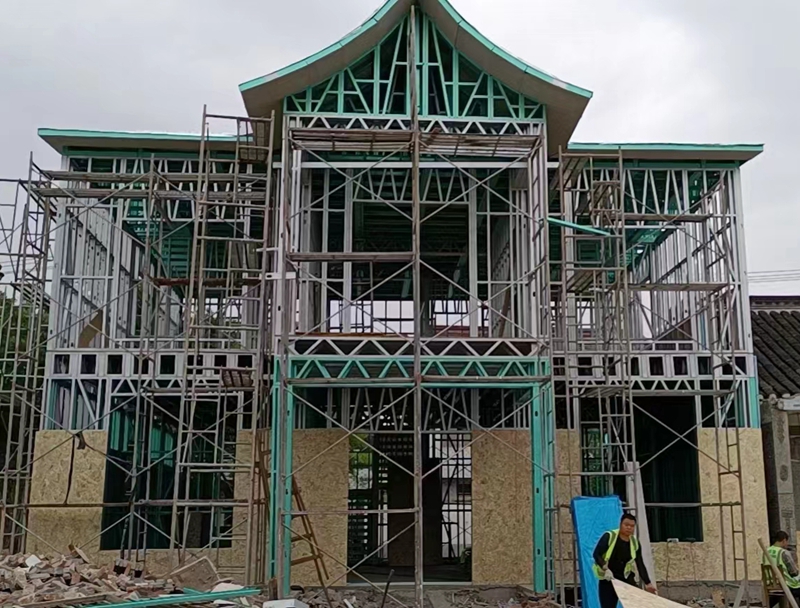How Should the Foundation of a Light Steel Villa Be Treated?
2024-07-26 21:24
In the construction of light steel villas, foundation treatment is a crucial step to ensure the safety and stability of the building structure. Light steel villas are increasingly favored by consumers due to their lightweight, environmentally friendly, and fast construction advantages. However, as the foundation supports the entire building, the quality of its treatment directly affects the villa’s lifespan and safety. Below is a detailed analysis of foundation treatment for light steel villas to help you better understand how to perform scientifically and rationally.

1. Understanding the Structural Characteristics of Light Steel Villas
Light steel villas are characterized by their lightweight, high-strength steel structures. Compared to traditional brick and concrete structures, they have a lower self-weight. The main structural components of light steel villas include light steel frames, wall panels with insulating cores, and roof panels. Due to their lighter weight, the foundation requirements are relatively lower, but this does not mean that foundation treatment should be neglected.
2. Choosing the Type of Foundation
Before treating the foundation, it is necessary to select the appropriate type of foundation based on geological conditions and building requirements. Common types of foundations include:
Strip Foundation: Suitable for more uniform soil conditions. Strip foundations are typically used to bear loads in a single direction.
Pad Foundation: Suitable for bearing dispersed loads, ideal for structures with distributed loads.
Pile Foundation: Suitable for poor geological conditions or inadequate soil bearing capacity. Piles transfer the load to deeper soil layers.
Raft Foundation: Suitable for soils with low bearing capacity, distributing the building load across a large foundation slab.
3. Foundation Treatment Steps
Geological Survey
A detailed geological survey must be conducted before foundation treatment. This includes assessing soil bearing capacity, groundwater level, soil layer thickness, etc. The geological survey report will provide the basis for foundation design and help select the appropriate type of foundation and treatment methods.
Site Preparation
Before construction begins, the construction site must be cleared of debris, vegetation, and surface soil. Site preparation also involves leveling the ground to ensure the accuracy of foundation construction.
Excavation and Foundation Pit Digging
The foundation pit should be dug according to design requirements, with depth and width conforming to design specifications. For soft soil or unstable soil layers, reinforcement measures such as foundation strengthening or support structures may be required.
Foundation Reinforcement
For insufficient soil bearing capacity, the following reinforcement measures can be taken:
Soil Replacement: Remove the existing soil and replace it with higher bearing capacity materials like gravel or other engineering materials.
Foundation Treatment: Methods such as compaction or grouting can be used to increase soil bearing capacity.
Pile Foundations: Install piles beneath the foundation to transfer loads to soil layers with higher bearing capacity.
Foundation Construction
After the foundation pit treatment is completed, proceed with foundation construction. Strip foundations, pad foundations, etc., require concrete pouring according to design drawings, ensuring that the quality and strength of the concrete meet standards. For pile foundations, ensure accurate depth and placement of piles.
Waterproofing
Waterproofing is a crucial part of foundation treatment, especially in areas with high groundwater levels. Measures such as waterproof membranes and drainage systems can be used to prevent groundwater from eroding and damaging the foundation.
Foundation Inspection
After foundation construction, an inspection is required, including checks on concrete strength, foundation settlement, and other aspects. Ensure that the foundation quality meets design requirements and can safely support the light steel villa’s load.
4. Special Considerations
Foundation Treatment in Seismic Zones
In seismic zones, foundation treatment is especially important. Consider the impact of seismic loads on the foundation, and implement seismic design measures such as foundation strengthening and seismic supports.
Foundation Treatment in Cold Regions
In cold regions, consider the effects of frozen soil on the foundation. Measures such as isolation layers or heating treatment can prevent damage to the foundation from frozen soil.
Soft Soil Foundation Treatment
On soft soil foundations, more complex treatment measures may be required, such as deep mixing or pile foundation reinforcement, to ensure foundation stability.
5. Conclusion
Foundation treatment for light steel villas is a key step in ensuring the safety and stability of the building. Through scientific and rational foundation design and treatment, the structure of the light steel villa can be effectively supported, avoiding safety hazards due to foundation issues. Understanding the choice of foundation, treatment steps, and special considerations will contribute to high-quality light steel villa construction. It is hoped that this detailed analysis will provide valuable reference and guidance in the construction of light steel villas.



